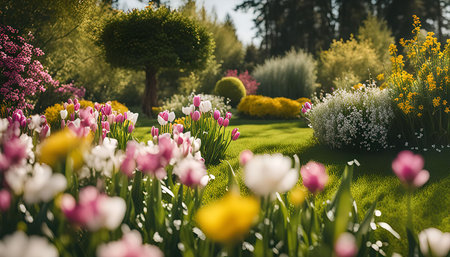An Introduction to Heritage Gardens and Spring Bulbs
Across the rolling landscapes of the United Kingdom, heritage gardens managed by the National Trust stand as living testaments to centuries of horticultural passion. These gardens, often nestled within grand historic estates, offer more than just a glimpse into the past—they invite us to witness nature’s changing pageantry through the seasons. As winter’s grip loosens and daylight lengthens, spring bulbs take centre stage, transforming these storied grounds into vibrant tapestries of colour and life. From snowdrops peeking through frosty soil to bold drifts of daffodils and tulips, spring bulbs have long played an essential role in shaping the seasonal beauty that draws visitors year after year. Their reliable return is not only a herald of warmer days but also a reflection of careful stewardship and traditional gardening wisdom passed down through generations. In this article, we’ll explore how the National Trust’s commitment to preserving both gardens and native bulb varieties ensures that each spring unfolds with a familiar yet ever-enchanting display, making these heritage spaces beloved havens for locals and travellers alike.
Traditional Varieties: The Heart of British Springtime
When it comes to spring bulbs in the heritage gardens maintained by the National Trust, few sights evoke more nostalgia or pride than the familiar swathes of daffodils, snowdrops, and bluebells. These cherished varieties are not just ornamental favourites; they represent centuries of horticultural tradition, embodying the very spirit of British springtime. For generations, these bulbs have flourished in stately home gardens and country estates, their annual return marking both a visual spectacle and a living link to our gardening past.
Daffodils: The Cheerful Heralds
The daffodil, with its vivid yellow trumpets, is perhaps the most quintessentially British of all spring bulbs. Known botanically as Narcissus, daffodils have been cultivated here since at least the 16th century and are woven into the fabric of our national identity – even celebrated every March on St David’s Day in Wales. In National Trust properties like Stourhead and Cliveden, visitors can wander through carpets of heritage daffodil cultivars that have persisted for generations, their resilient beauty a testament to careful stewardship and love of tradition.
Snowdrops: Delicate Beginnings
No other bulb signals winter’s end quite like the humble snowdrop (Galanthus nivalis). Arriving as early as January, snowdrops cluster beneath ancient trees or line woodland paths in many historic gardens. Their delicate white bells are often among the first flowers to appear after frost, offering hope and quiet joy to garden-goers. Several National Trust properties hold annual snowdrop walks, allowing visitors to appreciate both rare and native varieties that have naturalised over centuries.
Bluebells: A Magical Woodland Carpet
Come late April and May, British woodlands burst into colour with native bluebells (Hyacinthoides non-scripta), creating one of nature’s most enchanting displays. This iconic species thrives in undisturbed heritage landscapes—think Hinton Ampner or Blickling Estate—where ancient trees shelter vast colonies. Not only do bluebells paint a stunning picture each spring, but their presence also indicates a site’s age and ecological continuity.
Key Bulb Varieties in Heritage Gardens
| Bulb Variety | Typical Flowering Period | Cultural Significance |
|---|---|---|
| Daffodil (Narcissus) | March–April | National symbol; widely featured in literature and art |
| Snowdrop (Galanthus nivalis) | January–February | Symbolises hope and renewal; popular in winter garden walks |
| Bluebell (Hyacinthoides non-scripta) | April–May | Indicator of ancient woodland; beloved for naturalistic drifts |
The Enduring Appeal of Heirloom Bulbs
For many seasoned gardeners—and those who care for National Trust landscapes—the choice to plant traditional bulbs goes far beyond aesthetics. These time-honoured varieties connect us to earlier generations who walked these same lawns and paths each spring. They’re a living inheritance, thriving thanks to old-fashioned techniques like naturalising bulbs in grass or under trees. By nurturing these treasured species, we not only preserve a beautiful show each year but also uphold traditions that root us firmly in Britain’s gardening story.
![]()
3. From Past to Present: Stories from National Trust Gardeners
If you’ve ever wandered through a National Trust garden in early spring, you’ll know the magic of snowdrops dusting ancient lawns and daffodils nodding beneath centuries-old trees. But what’s often unseen is the dedication and wisdom of the gardeners who coax these bulbs into bloom year after year. Many of these green-fingered custodians are happy to share their stories, passing down tips that blend heritage practices with modern sensibility.
One seasoned gardener at Sissinghurst Castle recalls her first lesson: “Don’t be too quick to tidy up.” She explains that leaving foliage to die back naturally is essential for bulbs to store energy for next year’s display—a tradition rooted in patience rather than haste. Another head gardener at Stourhead swears by lifting and dividing crowded clumps every few years, echoing advice handed down since Victorian times. “It keeps the bulbs healthy and ensures a reliable show—just as it did for those before us,” he says.
Many National Trust gardens still use traditional tools: hand forks instead of powered cultivators, wooden markers passed from one generation to the next, and even home-made compost heaps layered with autumn leaves. These practices aren’t just quaint—they’re sustainable and respectful of both soil and history. As one retired gardener from Hidcote notes, “We treat our bulbs as family heirlooms; each one has a story, sometimes stretching back to when the garden itself was young.”
Visitors are often surprised to learn that even the most impressive drifts of crocus or bluebells began as small patches, carefully extended over decades. The gardeners’ advice? “Start small, choose varieties suited to your soil, and don’t rush nature.” It’s this steady approach—rooted in respect for both plant and place—that keeps these heritage gardens so enchanting every spring.
4. Designing With Bulbs: Tips From Heritage Estates
If you’ve ever wandered through the grounds of a National Trust property in spring, you’ll know that there’s something magical about the way bulbs are woven into the landscape. The gentle swathes of daffodils at Stourhead or the artful layering beneath ancient oaks at Sissinghurst do not happen by chance—they’re the result of generations of wisdom and time-honoured techniques. Drawing inspiration from these historic gardens, here’s how you can bring a touch of classic British charm to your own patch.
Layering Bulbs for Succession
One of the great secrets of heritage estates is the practice of “lasagne planting”—layering bulbs at different depths so that as one variety fades, another takes its place. This creates a prolonged display and makes the most of your garden space. Here’s a quick guide:
| Bulb Type | Planting Depth | Flowering Time |
|---|---|---|
| Tulips | 20cm deep | Late April – May |
| Daffodils | 15cm deep | March – April |
| Crocuses | 10cm deep | February – March |
| Snowdrops | 8cm deep | January – February |
Naturally British: The Art of Naturalising Bulbs
The hallmark of a true heritage spring display is a natural look—bulbs that appear to have gently tumbled into place over centuries. National Trust gardeners often use the “throw and plant” method: simply scatter bulbs by hand over lawns or under trees, then plant them where they land. This approach mimics nature’s randomness, giving rise to those informal drifts so beloved in British gardens.
Selecting Bulbs for Naturalising
Choose varieties that multiply over time—snowdrops, bluebells, and native daffodils are all favourites in historic estates. These bulbs thrive with minimal intervention and return reliably year after year.
A Few More Heritage Tips:
- Timing is everything: Plant bulbs in autumn while the soil is still warm but before frost sets in.
- Let foliage die back naturally: Cutting leaves too soon saps strength from next year’s blooms—a lesson well-learned by generations of estate gardeners.
- Add organic matter: Mix leaf mould or well-rotted compost into planting holes; this mirrors the rich, crumbly soils found beneath old trees in heritage parks.
- Mingle bulbs with perennials: Bluebells under apple trees or tulips among forget-me-nots capture that quintessentially British tapestry effect.
By following these practical, time-tested tips from National Trust properties, you’ll be well on your way to creating an enchanting springtime show—one that echoes both the beauty and quiet wisdom of Britain’s greatest gardens.
5. Celebrating Spring: Events and Traditions in National Trust Properties
Every year, as the first snowdrops and daffodils push through the soil, National Trust properties across the UK come alive with seasonal celebrations that mark the true arrival of spring. For many visitors and local communities alike, these gardens are not just places to admire nature’s handiwork—they are vibrant hubs where cherished traditions and new memories blossom side by side.
Guided Walks Through a Carpet of Blooms
One of the highlights of springtime at National Trust gardens is the array of guided walks designed to showcase the splendour of blooming bulbs. Knowledgeable volunteers, often with decades of experience, lead groups along winding paths beneath ancient trees, sharing stories about rare varieties of narcissi or the fascinating history behind a cluster of bluebells. For families, these walks are an opportunity not only to enjoy colourful scenery but also to hear tales from local lore—like how certain bulbs were first introduced by Victorian plant hunters or which patch of crocuses was favoured by past estate gardeners.
Community Gatherings and Local Festivities
Spring bulb displays often coincide with community events unique to each region. At some properties, you might find traditional tea tents set up on the lawn, offering homemade scones and cups of Earl Grey to visitors fresh from a stroll among the tulips. Other estates host open-air concerts or craft fairs during peak flowering weekends, creating a festive atmosphere where neighbours catch up over bunting and laughter. These gatherings aren’t just about admiring flowers; they’re about fostering a sense of belonging and continuity, echoing customs that have brought people together for generations.
Marking Seasonal Change in British Life
The appearance of spring bulbs has long been seen as a sign that winter’s hold is loosening—a cue for villages and towns to embrace lighter days ahead. Many Trust properties uphold age-old practices such as planting new bulbs with schoolchildren each autumn or holding informal competitions for the most impressive garden display. This intergenerational approach ensures that knowledge is handed down, while everyone—young and old—has a hand in nurturing the garden’s future beauty. As one seasoned gardener at a Yorkshire estate likes to say, “Spring bulbs remind us that patience brings reward, and every year there’s something new to marvel at.”
Whether it’s joining a bluebell walk in Kent or sharing hot cross buns under blossoming magnolias in Cornwall, celebrating spring among heritage gardens connects people not only to nature but also to their own rich cultural tapestry—a tradition that continues to bloom afresh each year within National Trust walls.
6. Preserving Beauty for Future Generations
When strolling through the magnificent heritage gardens cared for by the National Trust, one cannot help but reflect on the dedication that goes into preserving both the spring bulbs and the wider landscape for those yet to come. These gardens are not just a delight for today’s visitors; they are living legacies, carefully nurtured with an eye towards sustainability and continuity.
The conservation of spring bulbs—daffodils, snowdrops, bluebells, and more—is a task requiring patience and wisdom. Gardeners employ traditional practices such as careful lifting and dividing of bulbs, naturalising them in meadows, and maintaining soil health without reliance on chemical inputs. These methods have stood the test of time and are lovingly passed down from one generation to the next, echoing the rhythms of British gardening traditions.
Yet it’s not only about horticultural skill. The broader stewardship of heritage gardens involves community engagement, education, and fostering a sense of custodianship among volunteers and young people. Many National Trust properties run workshops or guided walks during spring bulb season, inviting families to learn about native species, local history, and the importance of biodiversity. These moments of sharing ensure that knowledge is not lost but grows richer with each retelling.
Sustainability is at the core of these efforts. Whether it’s composting green waste, reducing water use through mulching, or planting pollinator-friendly varieties alongside traditional bulbs, every action is taken with future generations in mind. The aim is to ensure that these gardens remain havens of beauty and wildlife long after we are gone—a gift to those who will walk these paths in years to come.
Ultimately, the ongoing care for spring bulbs within heritage settings is a quiet but profound act of hope. By tending to these living treasures with respect for nature and tradition, we honour the past while safeguarding a vibrant legacy for tomorrow’s custodians.


